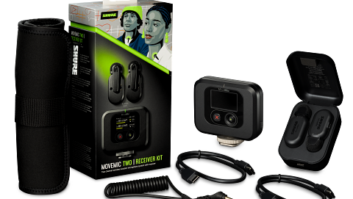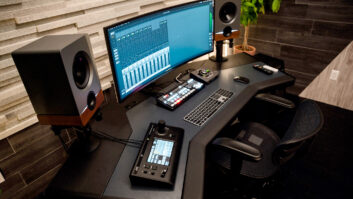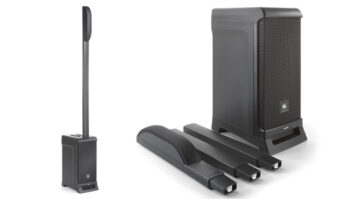More than 550 EAW MK and AX series boxes fill the bowl of the 42,000-seat Citi Field Stadium, the new home to the New York Mets.
While plenty of comfortable, modern sports facilities have sprouted up across the country in recent decades, New York City was saddled with the aging, decrepit baseball stadiums Shea and Yankee forever, with the former built in 1964 and the latter in 1923. In 2009, their replacements suited up to play, in the form of the Mets’ new home, Citi Field, and the creatively named Yankee Stadium.

On paper, the two new stadiums have lots in common. They were both designed by Populous (formerly HOK Sport), built by Hunt Construction Group, feature cutting-edge amenities, were largely funded by taxpayers, and house teams that are loathed by Boston Red Sox fans. They also both have audio systems designed by WJHW of Dallas; Yankee Stadium’s system was installed by AVI-SPL (Tampa, FL), while Citi Field’s was wired for sound by TSI-Global Companies, LLC. (St. Charles, MO).
“WJHW, TSI and AVI-SPL all worked together to do the St. Louis Cardinals’ Busch Stadium, so we looked at that as a template of sorts,” said Bradford Benn, director of Application Engineering at Crown (Elkhart, IN), who was involved in both stadiums’ installations. “We started on Cardinals almost four years ago, we did Nationals Park in Washington, DC with AVI-SPL, and then worked with them and TSI this year. We’ve gotten the system down, so we’re creating them faster with better quality, not reinventing the wheel every time. Everyone goes in and knows what’s going on.”
Each stadium uses primarily two-way and three-way boxes behind the seats, pointing downwards so that sound rolls into the bowl of the venue. Given the importance of sightlines, it was felt that while there would be a loss of 3 dB from the speaker placement, they would ultimately provide better control and sound quality than could be provided by single clusters on poles, blasting from the far side of the fields.
“There were immense similarities, but the teams were very insistent that the stadiums were different,” recalled Benn. “There’s only so many ways to skin the cat, and when you’re doing a baseball stadium, there’s a limited number of options. Once it’s decided you’re doing a distributed or cluster system, it all falls together. They both have distributed audio systems with no central cluster, and both have a high speaker and amplifier count as a result. For almost any project, whether it’s a stadium or a restaurant, it always starts at the output—the speakers, then you start sizing amplifiers back and processing back from there.”
Costing a reported $1.5 billion overall, Yankee Stadium had money in the budget for a comprehensive audio system. The main seating bowl features a slew of JBL boxes–AM-4212, PD-5322 and Control 30 speakers—while Meyer Sound UMS-1P ultra-compact subs can be found adorning the Great Hall video board and MM-4 miniature wide-range speakers cover the area around the Field Wall. A variety of ceiling speakers can be found in the stadium as well, with Tannoy CMS801 DC ceiling monitors used for suites and Radian 508/2BC coaxial ceiling speakers for cross-aisle systems.
For Yankee Stadium non-game areas, ceiling speakers rule the day with a variety of Tannoy ceiling monitors used for bathrooms, press boxes, team clubhouses, concessions and ticket windows, while Martin Audio C6.8T ceiling speakers are used in elevators and Technomad Vienna-16s are used at the entrances. All this adds up to around 1,300 speakers throughout the venue, powered by a whopping 230 Crown amplifiers, including CT 600, CT 1200, CT 2000, CT 3000 and CT 4200 USP/CN. The stadium’s audio is mixed on a Yamaha PM5D console.
While the cost of Citi Field made it a comparative bargain (only $900 million!), it’s no slouch when it comes to all matters audio. More than 550 EAW MK and AX series boxes fill the bowl of the 42,000-seat stadium, one key element being a customized version of the AX364-210 arrayable install loudspeaker with a 60×40 horn, modified to fire simultaneously forward, down and to the rear. A pair of 10-inch woofers was added to the cabinet, aimed downward to cancel low-frequency buildup. Meanwhile, EAW under-balcony speakers are also used, and smaller clusters made up of EAW MK5396, MK5364 and MK2396 loudspeaker enclosures serve seats on the field’s main level and outfield seating sections. Audio is delayed vertically through the upper and middle-tier levels, with delays ranging from 35 ms to 95 ms, computed using Smaart software.
“With a distributed system, everything is a delay ring, so it’s time consuming to go through and set each delay time,” said Benn. “Using software, you can set them quickly, but you have to set them all evenly before you can start using the system. If you want Section 212 to sound coherent with Section 210 sitting next to it, you have to go through and delay compensate each appropriately. It takes a lot of power, but we’ve gotten the hang of it; for instance, we figured out that instead of calling them out by speaker number, you call them out by seating sections. That way, you’re out there with the test microphone, you can say ‘I’m in 212,’ work backwards and be able to set your delay quickly.”
Much like at Yankee Stadium, Tannoy and JBL speakers are also present at Citi Field, with JBL Contractor Series Control 29s used in suites as well as above some seats out in left field and home plate. Meanwhile, fans otherwise occupied visiting the restrooms and concession stands can follow the game via Tannoy CMS6 and Di6 DCT loudspeakers. A Yamaha MC7L console mixes sound for the ballpark.
For Citi Field, there are 160 Crown CT 3000 amplifiers, along with 61 CT 1200 and 19 CT 2000 amps with PIP-Lite modules to power all main bowl speakers, club areas, suites, concession stands, bathrooms and entrances. All the Crown amps are tied together with Harman HiQnet System Architect and BSS Audio Soundweb London processors; a full 20 BSS BLU-120, 14 BLU-160, 10 BLU-80, and eight BLU-800 devices handle control of all stadium audio.
Despite some similarities between Yankee and Citi Field Stadiums, the two teams are still cross-town rivals, and that spirit can be found in their audio systems as well. “From talking with people, it seemed as if there was a competition between the two,” laughed Benn. “It wasn’t so much concern about system parity as it was ‘The Mets can’t be the little brother to the Yankees!’ They both wanted world-class sound—and WJHW made sure they both got world class.”
Crown
www.crownaudio.com
EAW
www.eaw.com
Harman Professional
www.harmanpro.com
Meyer Sound Laboratories
www.meyersound.com
Tannoy
www.tannoy.com/Professional.aspx
Yamaha Commercial Audio Systems
www.yamahaca.com
BSS Audio
www.bssaudio.com




